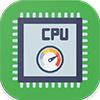| Name: | Intel Celeron N2805 |
| Family: | Intel Celeron |
| Group: | Intel Celeron J1000/N2000 |
| Segment: | Mobile |
| Generation: | 6 |
Intel Celeron N2805 Benchmark, Test and specs
Last updated:

CPU lineage
The Intel Celeron N2805 features 2 processor cores and has the capability to manage 2 threads concurrently. It was released in Q3/2013 and belongs to the 6 generation of the Intel Celeron series. To use the Intel Celeron N2805, you'll need a motherboard with a BGA 1170 socket.
CPU Cores and Base Frequency
The Intel Celeron N2805 has 2 CPU cores and can calculate 2 threads in parallel. The clock frequency of the Intel Celeron N2805 is 1.46 GHz
| CPU Cores: | 2 |
| Threads: | 2 |
| Cores: | 2x |
| Core architecture: | normal |
| Hyperthreading: | No |
| Overclocking: | No |
| Frequency: | 1.46 GHz |
Internal Graphics
The Intel Celeron N2805 has integrated graphics, called iGPU for short. Specifically, the Intel Celeron N2805 uses the Intel HD Graphics (Bay Trail GT1), which has 32 texture shaders and 4 execution units. The iGPU uses the system's main memory as graphics memory and sits on the processor's die.
| GPU name: | Intel HD Graphics (Bay Trail GT1) |
| GPU frequency: | 0.31 GHz |
| GPU (Turbo): | 0.67 GHz |
| Execution units: | 4 |
| Shaders: | 32 |
| Max. GPU Memory: | 2.0 GB |
| Max. displays: | -- |
| Generation: | 7 |
| Direct X: | 11.2 |
| Technology: | 22 nm |
| Release date: | Q3/2013 |
Hardware codec support
A photo or video codec that is accelerated in hardware can greatly accelerate the working speed of a processor and extend the battery life of notebooks or smartphones when playing videos.
| h265 / HEVC (8 bit): | No |
| h265 / HEVC (10 bit): | No |
| h264: | Decode / Encode |
| VP8: | No |
| VP9: | No |
| AV1: | No |
| AVC: | Decode / Encode |
| VC-1: | Decode |
| JPEG: | Decode |
Memory & PCIe
The processor supports a maximum memory capacity of 4.0 GB distributed across 1 memory channels. It offers a peak memory bandwidth of 8.6 GB/s. Both the type and quantity of memory can have a substantial impact on the overall system performance.
| Memory type: | DDR3-1066 |
| Max. Memory: | 4.0 GB |
| Memory channels: | 1 |
| Bandwidth: | 8.6 GB/s |
| ECC: | No |
| PCIe: | pci |
| AES-NI: | No |
Thermal Management
The processor has a thermal design power (TDP) of 4.3 W watts. TDP indicates the cooling solution needed to effectively manage the processor's heat. It generally provides an approximate indication of the actual power consumption of the CPU itself.
| TDP (PL1 / PBP): | 4.3 W |
| TDP (PL2): | None |
| TDP up: | None |
| TDP down: | 2.5 W |
| Tjunction max: | 80 °C |
Technical details
The Intel Celeron N2805 is manufactured using a 22 nm process. A smaller manufacturing process indicates a more contemporary and energy-efficient CPU. In total, this processor boasts a generous 1.0 MB cache. A substantial cache can significantly enhance the processor's performance, particularly in scenarios like gaming.
| Technology: | 22 nm |
| Chip design: | Monolithic |
| Socket: | BGA 1170 |
| L2-Cache: | 0 bytes |
| L3-Cache: | 1.0 MB |
| Architecture: | Bay Trail |
| Operating systems: | Windows 10, Linux |
| Virtualization: | VT-x, VT-x EPT |
| Instruction set (ISA): | x86-64 (64 bit) |
| ISA extensions: | SSE4.1, SSE4.2 |
| Release date: | Q3/2013 |
| Release price: | -- |
| Part Number: | -- |
| Documents: | Technical data sheet |
ADS
Benchmarks
 Geekbench 3, 64bit (Multi-Core)
Geekbench 3, 64bit (Multi-Core)
|
|
Intel Atom N2800
2C 4T @ 1.86 GHz
|
1094
|
|
|
Intel Pentium D1509
2C 2T @ 1.5 GHz
|
1088
|
|
|
Intel Celeron N2805
2C 2T @ 1.46 GHz
|
1027
|
|
|
AMD A4-1200
2C 2T @ 1.0 GHz
|
1009
|
|
|
AMD A4-1250
2C 2T @ 1.0 GHz
|
1006
|
 Geekbench 3, 64bit (Single-Core)
Geekbench 3, 64bit (Single-Core)
|
|
Intel Atom E3825
2C 2T @ 1.33 GHz
|
616
|
|
|
Intel Atom E3815
1C 1T @ 1.46 GHz
|
591
|
|
|
Intel Celeron N2805
2C 2T @ 1.46 GHz
|
591
|
|
|
Intel Atom E3815
1C 1T @ 1.46 GHz
|
591
|
|
|
AMD A4-1250
2C 2T @ 1.0 GHz
|
569
|
 Estimated results for PassMark CPU Mark
Estimated results for PassMark CPU Mark
|
|
AMD E-240
1C 1T @ 1.5 GHz
|
371
|
|
|
Intel Celeron 440
1C 1T @ 2.0 GHz
|
366
|
|
|
Intel Celeron N2805
2C 2T @ 1.46 GHz
|
332
|
|
|
Qualcomm Snapdragon 400
NoneC NoneT @ --
|
323
|
|
|
Intel Atom N2600
2C 4T @ 1.6 GHz
|
323
|
 Geekbench 5, 64bit (Multi-Core)
Geekbench 5, 64bit (Multi-Core)
|
|
AMD G-T56N
2C 2T @ 1.65 GHz
|
294
|
|
|
Qualcomm Snapdragon 410 LTE
NoneC NoneT @ --
|
282
|
|
|
Intel Celeron N2805
2C 2T @ 1.46 GHz
|
280
|
|
|
Qualcomm Snapdragon 400
NoneC NoneT @ --
|
273
|
|
|
AMD E2-2000
2C 2T @ 1.75 GHz
|
273
|
 Geekbench 5, 64bit (Single-Core)
Geekbench 5, 64bit (Single-Core)
|
|
MediaTek Helio A20
NoneC NoneT @ --
|
148
|
|
|
Qualcomm Snapdragon 600
NoneC NoneT @ --
|
148
|
|
|
Intel Celeron N2805
2C 2T @ 1.46 GHz
|
148
|
|
|
Qualcomm Snapdragon 600
NoneC NoneT @ --
|
148
|
|
|
MediaTek Helio A20
NoneC NoneT @ --
|
148
|
 Cinebench R15 (Multi-Core)
Cinebench R15 (Multi-Core)
|
|
Intel Pentium D1509
2C 2T @ 1.5 GHz
|
46
|
|
|
AMD E1-6010
2C 2T @ 1.35 GHz
|
45
|
|
|
Intel Celeron N2805
2C 2T @ 1.46 GHz
|
45
|
|
|
AMD E1-6010
2C 2T @ 1.35 GHz
|
45
|
|
|
Intel Pentium D1507
2C 2T @ 1.2 GHz
|
37
|
 iGPU - FP32 Performance (Single-precision GFLOPS)
iGPU - FP32 Performance (Single-precision GFLOPS)
|
|
Intel Atom Z3770
4C 4T @ 1.46 GHz
|
43
|
|
|
Intel Atom Z3740
4C 4T @ 1.33 GHz
|
43
|
|
|
Intel Celeron N2805
2C 2T @ 1.46 GHz
|
43
|
|
|
Intel Core i5-661
2C 4T @ 3.33 GHz
|
43
|
|
|
Intel Atom Z3740
4C 4T @ 1.33 GHz
|
43
|
 Cinebench R15 (Single-Core)
Cinebench R15 (Single-Core)
|
|
Intel Celeron N2910
4C 4T @ 1.6 GHz
|
26
|
|
|
Intel Pentium D1509
2C 2T @ 1.5 GHz
|
25
|
|
|
Intel Celeron N2805
2C 2T @ 1.46 GHz
|
23
|
|
|
Intel Pentium D1507
2C 2T @ 1.2 GHz
|
20
|
 Cinebench R11.5, 64bit (iGPU, OpenGL)
Cinebench R11.5, 64bit (iGPU, OpenGL)
|
|
AMD E-450
2C 2T @ 1.65 GHz
|
8.4
|
|
|
Intel Pentium J2900
4C 4T @ 2.41 GHz
|
8
|
|
|
Intel Celeron N2805
2C 2T @ 1.46 GHz
|
7.8
|
|
|
Intel Celeron J1900
4C 4T @ 2.0 GHz
|
7.7
|
|
|
Intel Celeron J1850
4C 4T @ 2.0 GHz
|
7
|
 Cinebench R11.5, 64bit (Multi-Core)
Cinebench R11.5, 64bit (Multi-Core)
|
|
Intel Pentium D1509
2C 2T @ 1.5 GHz
|
0.6
|
|
|
AMD E1-1200
2C 2T @ 1.4 GHz
|
0.5
|
|
|
Intel Celeron N2805
2C 2T @ 1.46 GHz
|
0.5
|
|
|
AMD E1-2100
2C 2T @ 1.0 GHz
|
0.5
|
|
|
AMD E-300
2C 2T @ 1.3 GHz
|
0.5
|
 Cinebench R11.5, 64bit (Single-Core)
Cinebench R11.5, 64bit (Single-Core)
|
|
AMD E1-1200
2C 2T @ 1.4 GHz
|
0.3
|
|
|
Intel Atom E3815
1C 1T @ 1.46 GHz
|
0.3
|
|
|
Intel Celeron N2805
2C 2T @ 1.46 GHz
|
0.3
|
|
|
Intel Atom E3815
1C 1T @ 1.46 GHz
|
0.3
|
|
|
AMD E1-1200
2C 2T @ 1.4 GHz
|
0.3
|